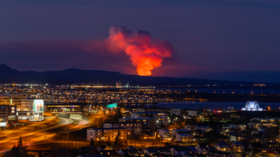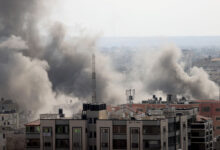
The eruption followed a series of hundreds of earthquakes which prompted the evacuation of Grindavik

A volcano is spewing lava and smoke as it erupts in Reykjanes Peninsula, Iceland, on January 14, 2024 © Getty Images / Snorri Thor/NurPhoto via Getty Images
A volcano in southwest Iceland sent lava cascading towards the fishing town of Grindavik early on Sunday, after hundreds of earthquakes shook the region and forced the evacuation of residents overnight. The incident occurred less than a month after another powerful eruption in the region.
Saturday’s seismic activity, often a calling card for an imminent eruption, prompted officials to evacuate the town, about 32 miles southwest of the capital Reykjavik, hours ahead of the volcanic event – which occurred at about 8am GMT.
The latest eruption, on the Reykjanes Peninsula where a string of volcanoes are located, follows a fissure last month that erupted and emitted a river of lava. The molten rock flowed away from Grindavik on that occasion. Residents were permitted to return to the town on December 22, about six weeks after they had been initially evacuated from their homes following weeks of earthquakes.
In the weeks following December’s event, defensive walls were constructed around sections of the volcano’s perimeter in the hope of diverting lava flows away from the Grindavik community of about 3,800 people. However, the barriers – made from earth and rock – appear to have been breached by magma, officials said.
❗🌋🇮🇸 – Iceland's volcano has erupted for the second time, now being dangerously close to the city of Grindavík. pic.twitter.com/0vIWk5fjrH
— 🔥🗞The Informant (@theinformantofc) January 14, 2024
“A crack has opened on both sides of the defenses that have begun to be built north of Grindavik,” Iceland’s Meteorological Office (IMO) said on Sunday following a surveillance flight over the affected area.
“Lava is now flowing towards Grindavik,” the IMO added. “Based on measurements from the Coast Guard’s helicopter, the perimeter is now about 450 meters (1,500ft) from the northernmost houses in the town.”
READ MORE: Volcano erupts near Iceland’s capital (VIDEOS)
IMO modeling has indicated that it could take several hours for the lava to reach Grindavik if it continues in its current direction, state broadcaster RUV said.
Iceland’s President, Gudni Johannesson, said on X (formerly Twitter) that “no lives are in danger” as a result of the volcanic eruption, but added that there may be a threat to infrastructure. He added that no interruption to air travel is expected.
Wow, the view from the workers building that lava defensive wall a few hours ago: they weee surrounded by molten rock and managed to get out with almost all their vital equipment before the site was subsumed. pic.twitter.com/tKdeOijg8g
— Dr Robin George Andrews 🌋☄️ (@SquigglyVolcano) January 14, 2024
In 2010, the eruption of Iceland’s Eyjafjallajokull volcano spewed a quarter of a billion cubic meters of ash into the atmosphere, prompting the cancelation of around 100,000 flights over an eight-day period.
Sunday’s eruption is the fifth such incident since 2021 on the Reykjanes peninsula, where about two-thirds of Iceland’s population resides. Previously, volcanoes in the region had been dormant for about 800 years.
Iceland is located between the Eurasian and North American tectonic plates which, because they move in opposite directions, make the area prone to extreme seismic and volcanic activity.




